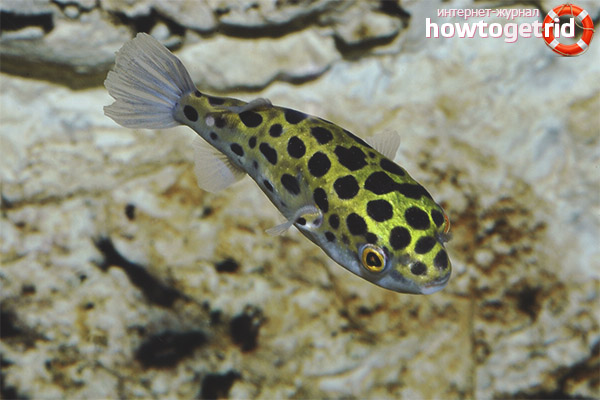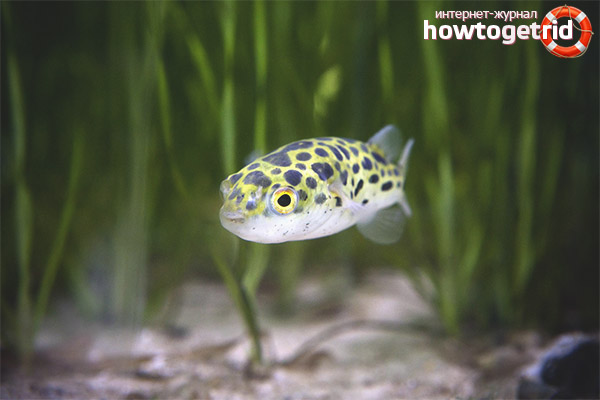The content of the article
Green tetradone is a poisonous fish, which cannot be fed from hands or touched. An interesting feature of this species is that the fish can inflate. It has a greenish tinge with dark spots on the back. The abdominal region is white, eye-catching, the eyes are large. Playful and convivial look suitable for keeping in aquarium conditions, but not for beginners. A variety of fish is designed for professionals.
Fish features
- Representatives of the aquatic environment are ranked as a family of puffer fish. Their natural habitat is salty springs, but fish can also be found in fresh water. Most often they live in Vietnam, India, Thailand. They can be found in Sri Lanka, in Malaysia and Bangladesh.
- The closest relative of the green tetradon is a puffer fish, which is eaten, but it is toxic.If the fugu is improperly heat treated, the person risks poisoning and dying.
- The fish discussed are also toxic, but their poison is not as strong. Therefore, if a person decides to immerse his hands in an aquarium, care must be taken. The aquatic inhabitant painfully bites, and it is necessary to bear this in mind.
- When members of the family feel in danger, they inflate, sharp needles appear in the area of the peritoneum. Due to this feature tetradon protects itself from other predatory inhabitants.
- Since constant stress leads to a deterioration in the health of pets, you can not scare them specifically to satisfy their curiosity. Otherwise, the fish may die from frequent attacks. Tetradons are so sensitive that they can swell because of the host that passed next to the aquarium.
Description and temperament
- According to the hull format, the fish are elongated, resemble a pear. The body smoothly flows into a large enough head, which is half the size of the entire length.
- The skin is dense, there are sharp thorns. If the fish is calm, the skin is tight.But when the tetradon gets scared, it gets inflated.
- The eyes are large, round, mostly black. They rotate in a circle, so the fish does not have to move in order to observe the situation. This helps the tetradons to hunt and defend themselves without moving the body.
- The fins are transparent, may be greenish or reddish, slightly shine. There is no clear indication of what gender an individual is in front of you. It is difficult to determine whether it is a male or female. The only thing that can be said for sure is that the female individuals are more rounded and elongated.
- Fishes were loved by many aquarists for their intelligence and intellectual abilities. They quickly become attached to the owner, remember the person feeding them. That is, when a pet eats from a single hand for a long time, then, when looking at the owner, it will float around the perimeter of the aquarium next to the glass in order to attract attention to its person. Therefore, many aquarists compare tetradons with cats or dogs.
- If poison is toxic for a person, but it is possible to survive, then for the remaining aquatic inhabitants, the fish of the represented family is dangerous. She periodically falls into aggression, so she can bite off her neighbors in the aquarium with fins and cause other heavy injuries.
- Shellfish can not be in the same dwelling with the tetradon, as well as invertebrates. All these inhabitants are perceived as live food and are immediately eaten. To their relatives fish do not show obvious aggression. They are best kept in a species aquarium group or one at a time.
Content
- If you plan to have one tetradon, then prepare a water home with a volume of 100 liters or more. For a couple it is better to choose an aquarium from 300 liters. So that pets can find where to roam. It is important to leave space for maneuvers and at the same time plant vegetation and create rocks.
- These fish jump well, so you need to install a cover on the tank, so as not to catch the spiny pets on the floor. In nature, tetradons jump from water sources into puddles to search for food, then return back to the reservoir.
- The complexity of the content lies in one detail: adults need brackish water (1,018-1,022), while the youngsters feel better in fresh water (1,005-1,008). If adult fish contain no salt, then their lifespan is reduced, pets often get sick.
- Fish cannot adapt to dramatic changes in water characteristics; they practically do not survive in the presence of ammonia and other toxins. As for acidity, it should be within 8 units.Stiffness - 10-18 units, temperature regime - 23-28 degrees.
- Since when fish eat, they leave behind a lot of waste, it is important to take care of the presence of a powerful filter. At the same time, the device will create the current needed by the tetradons. Experts advise to put an external filtering mechanism, which drives from 5 to 10 volumes per hour. Do not forget to weekly drain a third of the liquid, replacing it with a new one.
- Obligatory purchase a large aquarium, if you are going to acquire several represented individuals. The problem is that tetradons belong to territorial fish, therefore, in close capacity, skirmishes with other inhabitants are inevitable.
- These fish need a large number of shelters. Such a move will allow to delimit the territory. Also tetradons will not come across the eyes of other inhabitants of the aquarium. Do not forget that the individuals represented are very poisonous. They are forbidden to feed from the hands or touch.
- In addition, it is worth mentioning separately that tetradons are not recommended for beginners. As for juveniles, there are no particular problems with their content.They feel great in fresh water. And adult tetradons are best suited sea water or brackish.
- To independently try to create conditions similar to the wild, you will have to make a lot of effort. In addition, professional experience is required. That is why the considered fish is best to get knowledgeable people. A characteristic feature of tetradons is that they lack scales. That is why they are susceptible to various diseases. Fish will need careful treatment.
- Consider the fact that tetradons need large and spacious aquariums. Only for one adult fish need 150-170 liters. In addition, you need a powerful filter. The problem is that individuals leave behind a large amount of waste.
- A significant problem with tetradons is that their teeth grow very quickly. To make it easier for fish to live in an aquarium, they constantly need to grind their teeth. Do not worry ahead of time, do not have to do it yourself. In the diet of tetradons there should be a large number of mollusks that have a solid shell.
Feeding
- As for food, tetradons belong to omnivorous individuals. Separately, it is worth mentioning that the main part of the diet should be predominantly protein foods. In the wild, such fish feed mainly on all sorts of invertebrates. They sometimes eat plants and are very fond of crabs, mollusks, shrimp.
- As for the feeding process, then everything is extremely simple. Fish eat excellent dry food in flakes, live and fresh-frozen food, crab meat, snails, bloodworms, Artemia, shrimp. Adult tetradons prefer fish fillets and squid meat.
- Tetradons possess rather strong teeth that actively grow throughout life. If the fish do not grind them in time, the teeth begin to outgrow. It is for this reason that the specimens in question are strongly recommended to give snails that have a hard shell. And this food should be daily. Otherwise, the teeth will have to grind them by hand.
Green tetradons are fish not for beginners, because there are some difficulties in the content. However, if you still decide to become the owner of the presented family, take care of the appropriate equipment for the aquarium.Feed the fish according to all the rules, be especially careful in tactile communication with the pet.
Video: aquarium fish green tetradon













To send